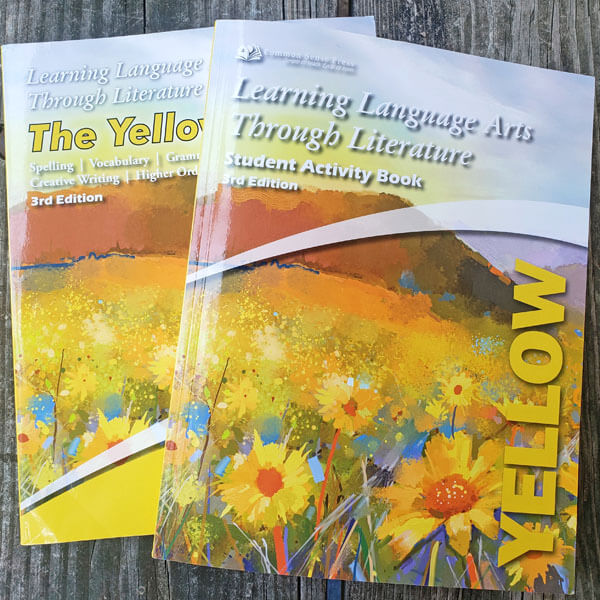Literature-Based Language Arts Curriculum
Help your kids learn and apply language skills in a meaningful way with this literature-based language arts curriculum.
I’ve always believed that isolating language arts from other subjects is the least effective way to develop language skills.
Repetitive grammar worksheets, random spelling lists, rote memorization of vocabulary words—none of these give students a meaningful way to apply what they are learning.
But for years I was stumped on how to integrate language arts with other core subjects because my kids strongly prefer a workbook-style curriculum. They like to see their assignments in a concrete format that they can work through as independently as possible.
This year, in an effort to make language arts meaningful for my daughter, I decided to try an integrated language arts curriculum for the first time.
To my surprise, I was able to find a workbook-based curriculum that uses quality literature to teach language arts—exactly what I was looking for!
I received this product for free and was compensated for my time. All thoughts and opinions are my own. I was not required to post a positive review. See our Disclosure Policy for more information.
Literature-Based Language Arts Curriculum
Learning Language Arts Through Literature (LLATL) is a complete language arts curriculum from Common Sense Press. Designed for first grade through high school, this curriculum is an excellent way to make language arts meaningful for students.
Each level of Learning Language Arts Through Literature has a Teacher’s Guide and a Student Activity Book (the “workbook” that makes my daughter so happy).
But this workbook isn’t just a typical workbook filled with repetitive exercises with no context. Instead, LLATL uses real literature to teach reading, grammar, creative writing, spelling, and more.
How We Use This Language Arts Curriculum
Kendra is using the Yellow Book, the third grade book in the Learning Language Arts Through Literature series. (Not sure which level to choose? Try this handy placement test!)
Day One
On the first day of each lesson, Kendra copies a literature passage in her workbook and checks it over for any errors. This copywork is an ideal way for kids to learn proper grammar and punctuation in a “real” setting—so much more effective than isolated exercises on a worksheet.
Next, she copies a list of 6 spelling words. One of the spelling words is taken directly from the literature passage; the others are words that follow a similar spelling pattern.
Day Two
On the second day, Kendra usually has a brief lesson based on the literature passage from the day before. For example, in Lesson 7, she learns about contractions and apostrophes based on the words I’ve and won’t in the literature selection from that lesson.
Then she practices her list of spelling words uses the “See-Spell-Say” method: look at each word, spell it out loud, and then say the word.
Day Three
The third day in LLATL’s Yellow Book is typically another brief grammar lesson or a short phonics review. Based on the word whistle in the literature passage in Lesson 7, Kendra learns that the letters -le at the end of a word usually combine with the consonant before them to make a separate syllable.
Day Three also includes more spelling practice through a Spelling Bee activity.
Day Four
The fourth day of the lesson is another language learning activity. The Day Four activities seem to vary a little more than the other days of each lesson. In Lesson 7, Kendra learns to write a list of friends’ names with last name first; then she practices listing them in alphabetical order.
She also takes a spelling pretest to prepare for the test on the final day of the lesson.
Day Five
The last day of each lesson focuses on creative writing, always in a way that relates to the literature passage from the first day.
In Lesson 7, Kendra makes a numbered list of reasons people might whistle (again, the word whistle was taken from the literature passage.) She also writes a paragraph about wanting to do something she can’t do, just as the literature passage focused on someone who was unable to whistle.
The writing assignments on Day Five tend to take more time than the other exercises, but the expectations are clearly outlined. In this assignment, Kendra is focusing on indenting the paragraph, capitalizing the first letter of each new sentence, and ending each sentence with a period.
I love that the writing topic is laid out for her—it saves me so much time and stress! I’ve noticed that the hardest part of writing for my kids is usually coming up with a topic. We get to skip that painful step with Learning Language Arts Through Literature!
Day Five ends with a spelling test. With only 6 words, the test is quick and easy. And another lesson is finished!
Common Sense Press is offering 15% off of your homeschool curriculum purchase when you use coupon code Summer2020 at checkout! Coupon code is valid through August 31, 2020.




